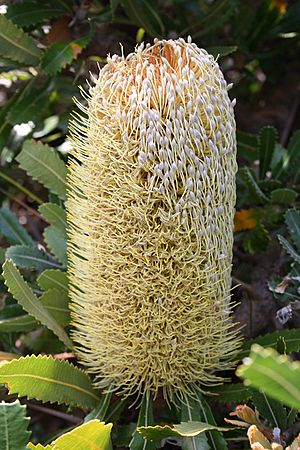Banksia ser. Banksia facts for kids
Quick facts for kids Banksia ser. Banksia |
|
|---|---|
 |
|
| Banksia serrata (Saw Banksia), the type species of Banksia. | |
| Scientific classification | |
| Kingdom: | |
| (unranked): | |
| (unranked): | |
| Order: | |
| Family: | |
| Genus: | |
| Series: |
Banksia L.f. ser. Banksia
|
| Synonyms | |
|
B. sect. Orthostylis Benth. |
|
Banksia ser. Banksia is a scientific name for a group of Banksia plants. In botany, a "series" is a way to group similar species together. This particular series is special because it includes Banksia serrata, also known as the Saw Banksia. This plant is the "type species" for the whole Banksia genus, meaning it's the main example that defines the group. Over time, scientists have changed their minds about which other Banksia species belong in this series.
Contents
How Scientists Grouped Banksia Plants
Scientists have studied Banksia plants for a long time to understand how they are related. They use different features, like how the leaves look or how the flowers are shaped, to put them into groups. This helps us understand the Banksia family better.
George Bentham's Ideas (1870)
In 1870, a scientist named George Bentham created a group he called Banksia sect. Orthostylis. He included Banksia species that had flat leaves with jagged edges, like a saw. He also looked at their "styles," which are parts of the flower. He noticed that in these plants, the styles were stiff and stood straight up after the flowers opened. This gave the seed cones a special look.
Bentham's group included many different Banksia species, such as:
- Banksia robur
- Banksia serrata
- Banksia ornata
- Banksia coccinea
- Banksia sceptrum
- Banksia menziesii
- Banksia speciosa
- And many others!
Alex George's Work (1981)
About a hundred years later, in 1981, another scientist named Alex George did a big study of Banksia plants. He kept the name Orthostylis, but he changed it from a "section" to a "series." He put it inside a larger group called Banksia subg. Banksia because these plants have long flower spikes.
George also changed how he defined the Orthostylis series. He only included species where the "pistil" (the female part of the flower) was hairy and clearly curved before the flower opened. This made the group much smaller, with only eight species. All these species had been in Bentham's original group, but many others were moved out.
The species in George's 1981 Banksia ser. Orthostylis included:
- Banksia serrata
- Banksia aemula
- Banksia ornata
- Banksia menziesii
- Banksia speciosa
- Banksia baxteri
- Banksia candolleana
- Banksia sceptrum
George noticed that some plants, like Banksia sceptrum, didn't fit perfectly. He also saw that these plants grew in both western and eastern Australia. He thought this meant the group was very old, spreading across southern Australia before dry areas like the Nullarbor Plain created a natural barrier, stopping plants from mixing.
Later, it was found that George's naming of B. ser. Orthostylis was not allowed by the rules of plant naming. Since this series contained Banksia serrata, the main example for all Banksia plants, it had to be called Banksia L.f. ser. Banksia instead. This was fixed in later publications.
Thiele and Ladiges' New Approach (1996)
In 1996, scientists Kevin Thiele and Pauline Ladiges used a different method called "cladistics." This method uses a lot of information about a plant's features to figure out its "family tree" (called a phylogeny). Their studies showed that some of George's groups might not be as closely related as he thought.
They found a group of plants that included all the species from George's B. ser. Banksia, plus four more species from another group called B. ser. Crocinae. Based on this, Thiele and Ladiges combined these groups into the B. ser. Banksia. They then split this larger series into two smaller groups:
- Banksia subser. Banksia: This included Banksia ornata, Banksia serrata, and Banksia aemula.
- Banksia subser. Cratistylis: This included the other species like Banksia candolleana, Banksia sceptrum, Banksia baxteri, Banksia speciosa, Banksia menziesii, Banksia burdettii, Banksia victoriae, Banksia hookeriana, and Banksia prionotes.
Alex George's Update (1999)
In 1999, Alex George published another big book about Banksia. He looked at the new information from Thiele and Ladiges but mostly stuck to his original grouping from 1981. For B. ser. Banksia, his new arrangement was almost the same as his 1981 one, except for a small change in the order of two species: Banksia baxteri and Banksia menziesii.
New Discoveries with DNA
Since 1998, scientist Austin Mast has been using DNA to study Banksia plants. By looking at their DNA, scientists can get a much clearer picture of how plants are related. His studies show that the old ways of grouping B. ser. Banksia might not be quite right.
It seems that the species previously grouped together in B. ser. Banksia actually belong to three different "family tree" branches. This means they are not as closely related as once thought. For example, some species are more closely related to other Banksia groups, like Banksia ser. Ochraceae and Banksia ser. Prostratae.
In 2007, Mast and Thiele started to make new changes to the Banksia family tree. They moved a group of plants called Dryandra into the Banksia genus. They also created a new main group called Banksia subg. Spathulatae for plants with spoon-shaped "cotyledons" (the first leaves of a seedling). All the plants in the B. ser. Banksia group are now part of Banksia subg. Banksia, but more detailed groupings are still being worked out as scientists finish studying all the DNA.
Images for kids
-
Banksia serrata (Saw Banksia), the type species of Banksia.
See also
 In Spanish: Banksia ser. Banksia para niños
In Spanish: Banksia ser. Banksia para niños


